By Fabien Schivre
The Kotelnikov dynamics processor series is probably best known for its transparent and precise behaviour. Despite this, the wide range of operation allows provoking musically interesting side-effects. The “Gentleman’s Edition” (GE) in particular features several musically useful modifications to the transparent “ideal” the concept is following by default.
This article will takes a closer look at various ways of pushing Kotelnikov to creative uses. Following examples utilize Kotelnikiov GE on the tracks, but some will also work fine with Kotelnikov Standard. Some of the following audio snippets are quite subtle. In doubt, turn up the monitoring level or use your headphones.
Transparent Dynamics Compression
Kotelnikov makes use of an advanced control mechanism combining two specialized sidechain paths:
- The Peak path to describes the true peak level of the incoming audio signal.
- The RMS describes the “body” of the audio input (not really RMS in fact, but that shouldn’t trouble us here).
Basically, the path generating the highest amount of gain reduction takes control of the audio output. This transition is not abrupt, but smooth and gradual.
In order to push Kotelnikov to its limits, we have to understand that RMS path controlled compression produces almost no harmonic distortion at all. This is a natural result of the technology employed, literally incapable to deliver any objectionable distortion:

The Peak path on the other hand, when taking control of the signal, is likely to produce strong amounts of harmonic distortion. Especially with fast settings:

This remarkable operational contrast is an important reason why this compressor works so well across a wide range material and settings. Only the RMS path is truly clean, the PEAK path is not. This is an intentional part of the design, and should be taken into account when trying to deviate from the norm.
Let’s compress a loop with aggressive settings. The sample intentionally contains background noise and hiss, which will help us to perceive how the compressor behave during the release phase:
Peak Stage Only, ~8db of Gain Reduction, 2ms Attack
Rms Stage Only, ~8db of Gain Reduction, 2ms Attack
Although we can notice subtle differences between the peak and RMS paths, the relatively strong harmonic distortion of the peak path can be difficult to perceive. The Peak version sounds more processed. The RMS version on the other hand sounds pretty clean. Their different nature become much more obvious when we listen to the Delta of each path (the difference between the compressor’s input and output):
Peak Stage, Delta
RMS Stage, Delta
This time the different nature of each path becomes much more obvious. We hear how the peak path precisely attacks wave by wave (and thus, produces plenty sharp harmonic series, and delivers good overload protection). The RMS delta on the other hand is very smooth and clean, but also grabs both to little and too much material than it really should. Each has advantages and drawbacks. The most useful results are typically found when both paths interact in a sensible manner:
Combined Peak and Rms Stages, ~8db of Gain Reduction, 2ms Attack
Peak Crest
The Peak crest parameter controls the balance between both paths (technically: The offset between their thresholds). Turn it counter-clockwise and the compression character becomes more and more aggressive, with the peak path taking over control during most situations. At extremes, the RMS path will turn off completely. Peak crest settings below ~2dB deliver aggressive compression styles, values between 2-8dB represent the sweet spot for fast and tight compression, and anything beyond 8dB results in very smooth compression. For more dirt and grit, you’ll most probably want to select a low Peak crest value, or in doubt, turn the RMS section off by turning the Peak Crest knob full left.
Kotelnikov’s peak path is extremely fast and precisely follows the configuration set by the operator. Aggressive settings can quickly lead to annoying artefacts, the trick is to prevent the peak path from controlling the “body”, the tonal parts of the signal, which would make the distortion far more audible. This balance can be directly controlled via the Peak crest setting.
Timing
Given a complex wideband input such as a stereo mixdown, a fast peak release in combination with a moderate RMS release time will generally produce the most transparent, artefact free compression results. The faster the Peak release timing, the more effective the compression will generally be. Fast release times substantially reduce the amount of long term high to low intermodulation distortion, the main cause of audible overcompression in wideband dynamics control. A fast timing tends to sound more natural and transparent than slow release times, despite the substantial increase of harmonics distortion. Given a balanced Peak crest value, this increase of harmonic distortion will mostly affect transients.
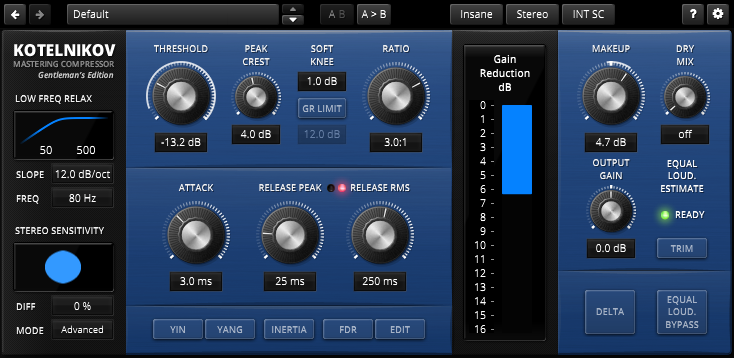
By default, with active peak and RMS paths and a sensible Peak crest setting, Kotelnikov will naturally avoid keeping the peak path active for too long durations. Instead, it will hand over control to the clean RMS section as soon as possible.
If transparency is not the main objective, the exact opposite could be worth a try. For example long peak release times in combination with fast RMS release settings, or very long release times in peak only mode (Peak crest full left), or very fast release times in RMS only mode (Peak crest full right).
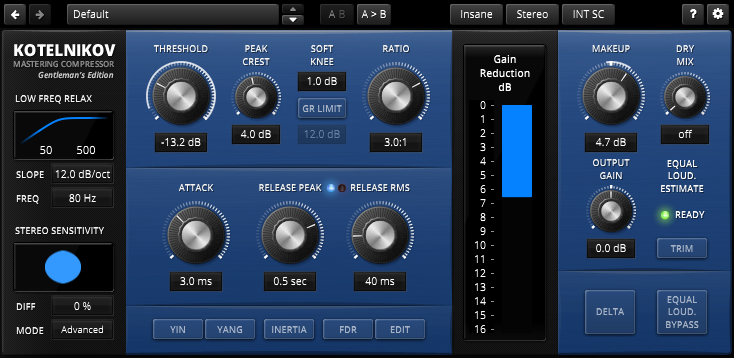
Let’s take a listen:
Conservative Setting
Opposite Setting
Note a slightly more artificial breathing in the second example, while the first sounds more tightly controlled.
Yin & Yang
The Yin and Yang buttons relax the symmetry of Kotelnikov’s detectors, which in turn provokes the production of a far greater amount of even ordered harmonics. Yin focusses on the LF region, Yang covers the HF area. These options also substantially affect how the compressor handles transient content.
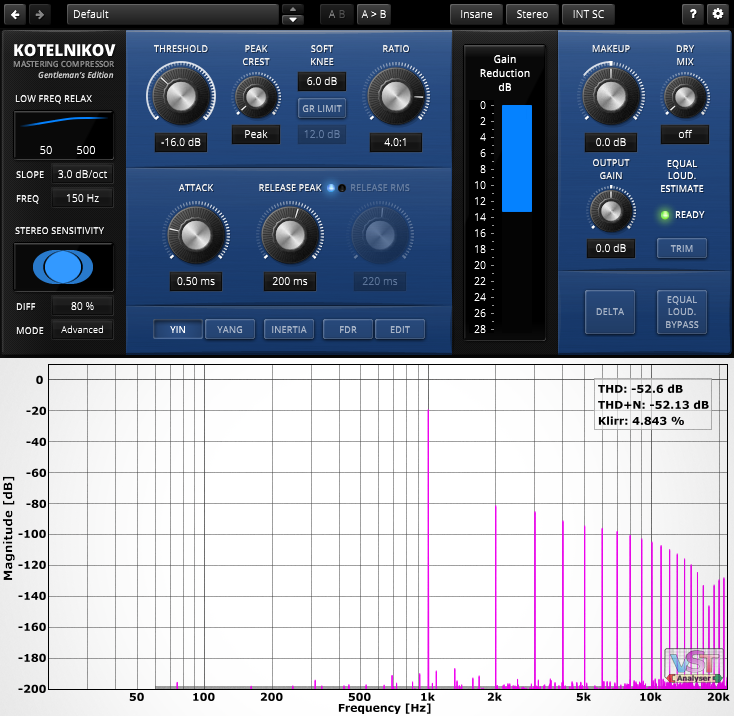
These features are not comparable to saturators, as they purely depend on the amount of gain reduction.
As such, the effect of Yin and Yang will directly grow with compression intensity and speed. Both options show their greatest effect with fast attack and release times, almost exclusively for the peak path. This offers the advantage that the Peak crest knob controls the amount/depth of Yin and Yang, with most of the effect is then being pushed towards transients content rather affecting than the whole signal.
Example:
Compression without Yin Yang
Compression with Yin Yang
Yin can add some sense of size to the low end, Yang can often add an interesting texture to voices and other lead instruments.
Inertia
Inertia modulates the attack and release times in relation to gain reduction. A low amount of gain reduction results in a slower, lazier behaviour, while high amount of gain reduction (GR) increase the detector’s speed.
The effect has similarities with the behaviour of opto-copplers. Dynamics processors built around them tend to behave somewhat “sticky” at low amounts of gain reduction (and general activity), and speed up at higher amounts of GR.
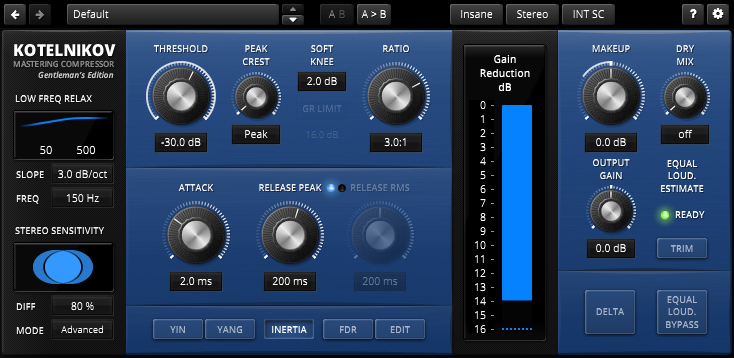
In addition, Inertia also gradually limits the maximal amount of gain reduction to 16dB. This is another aspect inherent to opto-copplers. This GR restriction produces smooth and transparent sounding S shaped gain transfer curves:
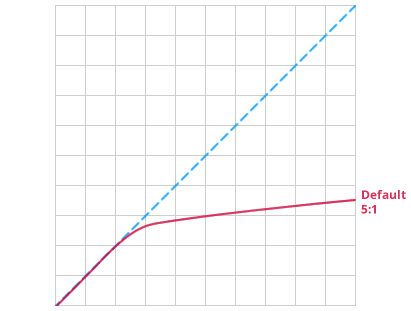
While inspired by the beneficial aspect of classic audio technology, Kotelnikov’s Inertia mode has none of the timing restrictions inherent to optically controlled dynamics processors.
Let’s take a listen:
Standard Compression
Compression with Inertia
The Inertia example has a much more relaxed feel to it, with the higher level events seemingly having more space. The effect is best explored with your own material.
Inverse Inertia
Holding the Alt key and pressing the Inertia button switches Kotelnikov into an inverse -Inertiamode (“Inverse Inertia”) designed to cover an exotic upward compression use-case.
This mode is specifically meant to operate at very deep thresholds, and with the intention to keep the GR limit fully “saturated” for most of the time. This results in a static attenuation for high energy content and a boost during low level passages. The GR limit is restricted to a few decibels only (2-6dB), in dependence of the ratio parameter.
As with Inertia, timing depends of the amount of gain reduction, but in an inverse manner and only for the release parameter (release time slows down with GR).
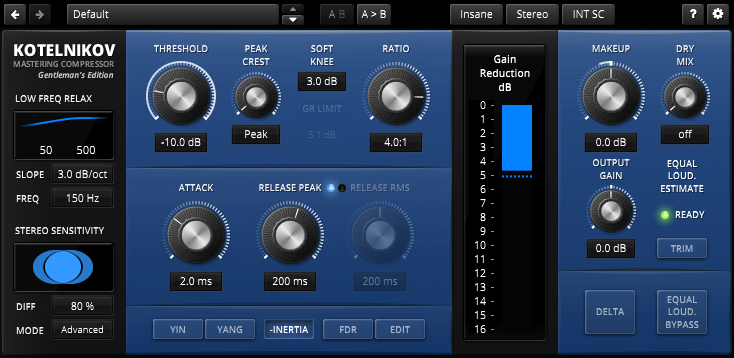
The -Inertia mode is generally very transparent, but can also work really well with otherwise completely crazy settings.
Frequency Dependent Ratio
Kotelnikov’s Frequency dependent ratio can also help keeping the side-effects of aggressive settings under musical control.
A shelf reducing ratio at low frequencies can add a nice weight to the signal, while compressing the upper frequency range:

Example:
Compression without FDR
Compression with FDR Low Shelf
Observe the LF region, a few beloved classic audio compressors exhibit similar spectral effects.
Another interesting alternative is the EL Curve, and its opposite:

The EL Curve accurately reproduces the relative differences between the equal loudness curves in dependence of playback level. With the settings shown above, the compressor will generate the strongest reduction (i.e. “ratio”) in the most audible regions.
Example:
Compression without FDR
Compression with Negative FDR Equal Loudness Curve
Note the smooth and warm character in this case. The opposite Equal Loudness Curve FDR on the other hand produces much sharper results:
Compression with Positive FDR Equal Loudness Curve
Your Turn!
All mechanisms described above can be combined to enhance the richness of compression sound in a subtle, stylish manner. Bear in mind that Kotelnikov’s wide parameter range can quickly produce unusable results, especially if timing parameters are set in a wildly extreme and random manner. A solid, transparent sounding setting is probably the best starting point for any creative fun and abuse.
Further References
- Music snippets taken from Soulparlor‘s Evoluzion
- Kotelnikov GE – Manual
- Kotelnikov video tutorial by Dan Worrall

